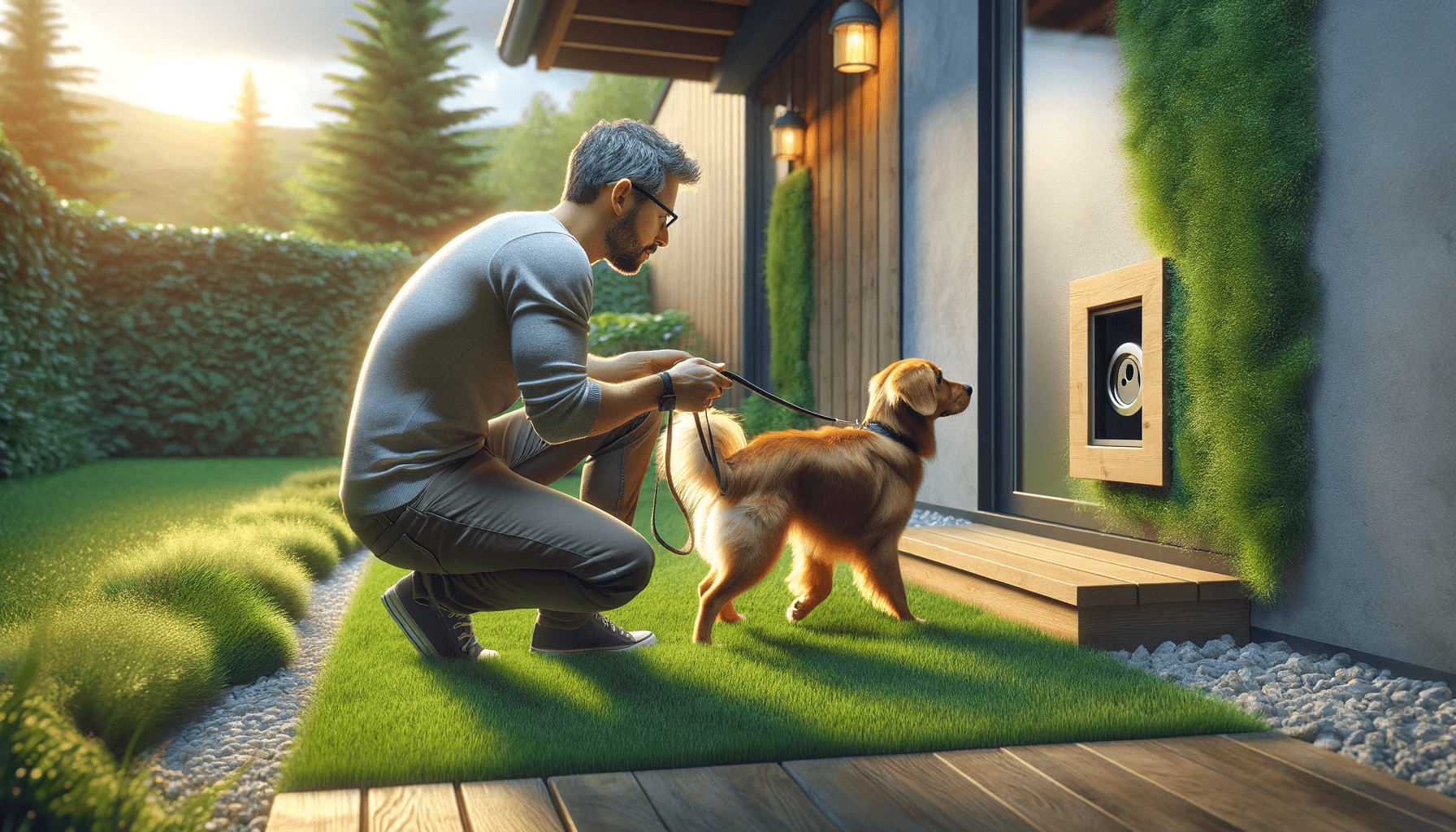Are you struggling with a leash reactive dog? Don't worry, we've got you covered.
In this article, we'll explore the six best training techniques for leash reactive dogs.
- Desensitization and counterconditioning: This technique involves gradually exposing your dog to triggers that cause reactivity, while pairing those triggers with positive experiences or rewards to change their emotional response.
- Positive reinforcement training: Using rewards and positive reinforcement techniques to reinforce desired behaviors and redirect your dog's attention away from triggers.
- Clicker training: A form of positive reinforcement training that uses a clicker to mark desirable behaviors, followed by a reward.
- Behavior adjustment training (BAT): This method focuses on giving your dog more control over their environment and teaching them alternative behaviors to replace reactive responses.
- Controlled leash walking: Implementing loose leash walking techniques and teaching your dog to focus on you, which can help prevent reactive behaviors.
- Engaging in mental stimulation: Providing your dog with puzzle toys, interactive games, and training exercises to keep their mind occupied and promote a calmer and more focused state.
By utilizing these training techniques, you'll have the tools you need to help your furry friend overcome their reactivity.
Let's get started!
Key Takeaways
- Gradually expose your dog to triggering stimuli
- Pair triggers with positive experiences or rewards
- Use rewards and positive reinforcement techniques
- Empower your dog to make their own choices
Desensitization and Counterconditioning
To effectively address leash reactivity in your dog, you need to desensitize them to triggering stimuli and countercondition their response.
Desensitization involves gradually exposing your dog to the stimuli that trigger their reactivity, such as other dogs or people. The goal is to expose them to these triggers at a distance or intensity that doesn't elicit a reactive response. By doing this, you're helping your dog develop a more relaxed and calm emotional state in the presence of these triggers.
Counterconditioning is another important technique that complements desensitization. It involves changing your dog's emotional response to the triggering stimuli. Through positive reinforcement, you can teach your dog that the presence of these triggers predicts something good, such as treats or praise. This helps to replace their negative associations with positive ones, gradually changing their emotional response.
When implementing desensitization and counterconditioning, it's crucial to be patient and consistent. Start with a distance or intensity that your dog can handle without reacting, and gradually decrease the distance or increase the intensity over time. Remember to always reward your dog for calm and relaxed behavior during these training sessions.
Positive Reinforcement Training
When it comes to positive reinforcement training for leash reactive dogs, there are two key points to focus on: rewards for good behavior and building trust and confidence.
By using rewards such as treats or praise, you can reinforce the behaviors you want to see more of, encouraging your dog to remain calm and focused on walks.
Additionally, positive reinforcement helps to build trust and confidence in your dog, strengthening the bond between you and making training more effective.
Rewards for Good Behavior
When training your leash reactive dog, one effective technique is to use rewards for good behavior through positive reinforcement training. Positive reinforcement techniques involve rewarding your dog for exhibiting desired behaviors, which encourages them to repeat those behaviors in the future. One popular method is clicker training, where you use a clicker to mark the exact moment your dog does something right, followed by a reward.
Here are four types of rewards you can use to reinforce good behavior:
- Treats: Use small, high-value treats that your dog finds irresistible.
- Toys: Offer your dog a favorite toy as a reward for good behavior.
- Praise: Use verbal praise, such as 'good boy/girl,' to acknowledge and reinforce their positive actions.
- Petting: Give your dog gentle strokes and pats as a form of reward and affection.
Building Trust and Confidence
Continue building trust and confidence in your leash reactive dog by consistently reinforcing positive behaviors through positive reinforcement training.
Trust building exercises are essential to help your dog feel secure and develop a stronger bond with you. Start by engaging in activities that promote trust, such as gentle touch, calm interactions, and consistent routines.
Additionally, providing your dog with plenty of positive experiences and rewards will help build their confidence. Confidence building activities can include introducing your dog to new environments and situations gradually, allowing them to explore at their own pace. Encourage and reward your dog for any brave or confident behavior they display.
Clicker Training
To effectively train a leash reactive dog, utilize clicker training as a valuable technique. Clicker training is a positive reinforcement method that uses a clicker to mark desired behaviors and reward them with treats or praise.
Here are some effective clicker training methods to help you train your leash reactive dog:
- Start by associating the sound of the clicker with a reward. Click and immediately give your dog a treat. Repeat this several times until your dog understands that the clicker means a reward is coming.
- Use the clicker to mark and reinforce positive behaviors. For example, if your dog remains calm when seeing another dog, click and reward them. This helps your dog understand that being calm is what you want.
- Gradually increase the difficulty by exposing your dog to more challenging situations. Click and reward for small steps towards improvement, such as looking at the other dog without reacting.
- Be consistent and patient. Training takes time and practice. Use the clicker consistently to reinforce desired behaviors and gradually reduce the need for treats as your dog becomes more reliable.
Behavior Adjustment Training (BAT)
Utilize BAT as an effective method for training your leash reactive dog. Behavior Adjustment Training (BAT) is a training approach specifically designed to help dogs overcome their reactive behavior. BAT techniques focus on empowering your dog to make their own choices and learn alternative behaviors. By allowing them to approach a trigger at a distance where they feel comfortable, you can help them build confidence and reduce their reactivity.
BAT success stories demonstrate the effectiveness of this training method. For example, dogs who were once reactive towards other dogs on walks were able to learn to greet them calmly and politely. This was achieved through controlled exposure to triggers and rewarding calm behavior. By giving your dog the opportunity to make positive associations and practice self-control, BAT can help them become less reactive over time.
During BAT training sessions, you should observe your dog's body language closely to ensure they aren't becoming overwhelmed. It's important to start at a distance where your dog is comfortable and gradually decrease the distance as they become more confident. Remember to reward your dog for calm behavior and give them breaks if needed.
Controlled Leash Walking
To effectively address leash reactive behavior in dogs, controlled leash walking is a crucial technique to implement.
This involves understanding the triggers that cause reactivity, utilizing positive reinforcement methods to encourage desired behavior, and incorporating desensitization and counterconditioning techniques to gradually change the dog's response.
Leash Reactivity Triggers
When encountering leash reactivity triggers, you should take control of the situation by using controlled leash walking techniques. This will help manage leash reactivity issues and create a more enjoyable walking experience for both you and your dog.
Here are some common leash reactivity triggers to be aware of:
- Other dogs: Many dogs become reactive when they see or approach other dogs on walks.
- People: Some dogs may react aggressively or fearfully towards strangers, which can lead to leash reactivity.
- Bicycles and skateboards: The fast movements of bicycles and skateboards can trigger reactive behavior in dogs.
- Loud noises: Sudden loud noises such as sirens or fireworks can startle dogs and cause them to become reactive.
Positive Reinforcement Methods
To effectively manage leash reactivity issues and create a more enjoyable walking experience, use positive reinforcement methods such as controlled leash walking.
One effective technique is clicker training. This method involves using a clicker to mark the desired behavior and then rewarding your dog with a treat. The clicker serves as a signal that tells your dog they've done something right, and the treat reinforces that behavior.
When using treats as rewards during training, make sure to choose high-value treats that your dog finds especially rewarding. This will help motivate them to focus on you and the training session.
Desensitization and Counterconditioning
Start by implementing desensitization and counterconditioning techniques to address leash reactivity in your dog. These methods involve gradually exposing your dog to the triggers that cause reactivity and pairing those triggers with positive experiences. Here are four steps to follow:
- Identify triggers: Determine what causes your dog to react on the leash, such as other dogs, bicycles, or loud noises.
- Gradual exposure: Start by exposing your dog to a low-intensity version of the trigger, such as a distant dog. Increase the intensity gradually as your dog becomes more comfortable.
- Reward-based training: Use treats, praise, and rewards to reinforce positive behavior and create positive associations with the triggers.
- Controlled leash walking: Practice controlled leash walking, where you maintain a safe distance from the triggers while rewarding your dog for calm behavior.
Engaging in Mental Stimulation
First, incorporate mental stimulation into your training routine to help address leash reactive behavior in your dog. Mental stimulation games and interactive toys can provide a great outlet for your dog's energy and help keep their mind engaged. These activities can help redirect their focus away from triggers that may cause them to react on the leash.
One option for mental stimulation is to play interactive games with your dog. Hide and seek, for example, can be a fun game that stimulates their senses and encourages problem-solving. You can hide treats or toys around the house or in the yard and let your dog use their nose to find them. This not only provides mental stimulation but also helps build their confidence and strengthens the bond between you and your dog.
Another way to engage your dog's mind is through the use of interactive toys. Puzzle toys, for instance, can challenge your dog to figure out how to retrieve treats or toys from inside. These toys require your dog to use their problem-solving skills and can keep them entertained for hours.
Incorporating mental stimulation into your dog's training routine can be a valuable tool in addressing leash reactive behavior. By engaging their mind, you can help redirect their focus and provide a positive outlet for their energy.
Frequently Asked Questions
Can Leash-Reactive Dogs Be Completely Cured With Desensitization and Counterconditioning Techniques?
You can't completely cure leash-reactive dogs with desensitization and counterconditioning techniques. While these methods are effective, they have limitations. However, they can greatly improve your dog's behavior and help manage their reactivity on walks.
Is Positive Reinforcement Training Effective for All Types of Leash-Reactive Behaviors?
Positive reinforcement training can be effective for most leash-reactive behaviors. However, punishment-based training may not address the underlying causes and can worsen reactivity. Leash reactive dogs can be trained to walk off-leash safely with proper guidance and training techniques.
How Long Does It Typically Take to See Results From Clicker Training for Leash-Reactive Dogs?
Typically, it takes time to see results from clicker training for leash-reactive dogs. To track progress, observe changes in their behavior during walks. Common challenges include distractions and maintaining consistency in training sessions.
Can Behavior Adjustment Training (Bat) Be Used in Combination With Other Training Techniques?
Yes, you can combine BAT with other training techniques to address leash reactivity in dogs. Incorporating BAT can provide benefits for fearful dogs, helping them to gain confidence and learn to react more positively in challenging situations.
Are There Any Specific Tools or Equipment Recommended for Controlled Leash Walking With Leash-Reactive Dogs?
For controlled leash walking with leash-reactive dogs, two recommended tools/equipment are head halters and front clip harnesses. These can help provide better control and redirect the dog's attention during walks.
Conclusion
In conclusion, implementing these training techniques can greatly benefit leash reactive dogs by helping them overcome their fears and anxieties.
Desensitization and counterconditioning can gradually change their negative associations, while positive reinforcement and clicker training can reinforce desired behaviors.
Behavior adjustment training (BAT) and controlled leash walking can teach them to stay calm and focused in the presence of triggers.
Lastly, engaging in mental stimulation can provide an outlet for their energy and prevent boredom.
With patience and consistency, these techniques can help leash reactive dogs become more confident and well-behaved.






